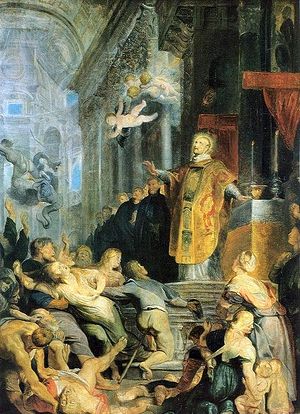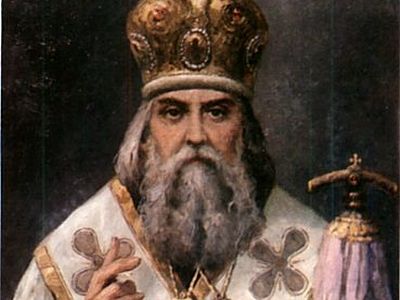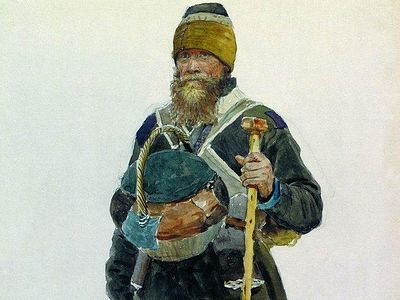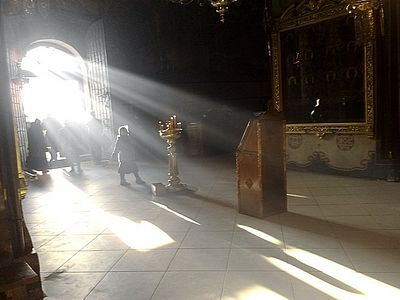 The Vision of St. Ignatius of Loyola (c.1491-1556)
The Vision of St. Ignatius of Loyola (c.1491-1556)
Such unlawful penetration into the spiritual world is dangerous in the highest extreme, especially since it inevitably stimulates false revelations, which draw in inexperienced people who are unacquainted with the basics of spiritual life, and destroys them spiritually and physically.[2] Two obvious examples of such “revelations” [in Russia] are those of the “Theotokos Center,” or the “White Brotherhood,” whose outrageous totalitarianism in their interpretation of Christianity speaks eloquently of the nature and worthiness of these “revelations.”[3]
What is needed for the “discernment of spirits” according to the Orthodox teaching? Saint Ignatius (Brianchaninov) gives a thorough and precise answer to this question in his article, “A Word on Sensual and Spiritual Vision of Spirits.”[4] We will note here the more essential thoughts in this article.
The lawful way to enter the spiritual world and receive true knowledge (revelation) about that world is through a correct spiritual life, presupposing some knowledge of the basics of the Orthodox Faith and spiritual life. The most important condition and indication of a person’s correct spiritual orientation are his awareness of the abnormality and destructiveness of his present spiritual state, and his powerlessness without God to become a new man in the image of Christ. From this comes contrition of heart, sincere repentance, and, what is most important to spiritual life, humility. Saint Ignatius writes,
The first spiritual vision is the vision of one’s own sins, which had been concealed before by forgetfulness and unknowing.… Seeing our inadequacies—this is a safe vision! Seeing our fall and redemption—this is a very needed vision.…[5] All the saints considered themselves unworthy of God. By this they revealed their worthiness, which consists in humility.[6]
In the Gospels all this is called spiritual poverty (Mt 5:3). Spiritual poverty is that unconditionally necessary state of the soul in which it is possible for a person to receive true revelation, and a true indication toward the path to the Kingdom of God. God gives this revelation to a person in order to save him, and not in order to satisfy the curious idle mind and empty heart of one who longs to know “what is there.” Bishop Ignatius writes:
Only to the perfect Christian, most often to a monastic who is worthy to see with the eyes of his soul, has the world of spirits been revealed. But even during the very height of monasticism there were very few such people, as Saint Macarius the Great testifies. The quality of all visions sent by God, as Saint John Climacus notes, is that they bring humility and contrition to the soul, fill the soul with the fear of God, the awareness of one’s own sinfulness and nothingness. But visions which we try to grasp willfully, against God’s will, lead us to high-mindedness and conceit, and bring a joy which is nothing other than the satisfaction of our ambition and vanity, though we may not understand this.[7]
The very nature of revelations also says much about whether or not they are true. If man before the fall was able to see spirits directly and commune with them, then in his present state he can see them only by God’s particular design, and in times of extreme need,[8] with the purpose of reforming and saving him. Therefore, all the holy fathers and ascetics who were experienced in spiritual life decisively warn the Christian about the possibility of falling into what is called prelest—that is, spiritual self-delusion, in which a person accepts his own neuro-psychological and often demonic stimulation and the false visions coming from it as divine revelation.
Saint Isaac the Syrian writes clearly, “Let no one deceive himself and be given over to the deception of visions, for the defiled soul does not enter into the pure kingdom and does not unite with the souls of the saints.”[9]
Saint Ignatius Brianchaninov warns:
Christian ascetical instructors command us generally not to pay attention to any phenomena that present themselves to our emotional and physical senses. They command us to observe a prudent coldness and saving caution towards all phenomena in general.[10]
The Holy Fathers command the ascetic of prayer to remain indifferent toward any phenomena that might occur within him or outside of him, and to pay no attention; he should consider himself unworthy of the vision of saints. They instruct on the one hand not to judge visions, so as not to judge a saint, but on the other hand never to believe in a vision or hastily accept it as true, in order to avoid falling into the snares of an evil spirit.[11]
In our times, when false mysticism and all manner of “miracles” are spreading in broad waves across all countries of the world (in the U.S., for example, nearly seventy percent of the population claim to have had an experience of extra sensory perception, and forty-two percent have communicated with the dead), it is especially important to remember these patristic warnings.
Why does a person fall into this state? The fathers answer, “All forms of demonic prelest … arise because repentance is not placed in the foundation of our prayer, because repentance was not made the source, soul, and purpose of prayer.”[12]
Saint Isaac the Syrian points to another important reason. It is the seeking and expectation of grace-filled feelings, visions, etc. Citing the words of the Savior, The Kingdom of God cometh not with observation (Lk 17:20), this great instructor of monasticism says,
What we seek with observation—I mean lofty Divine gifts—is not approved by the Church of God; and those who have received them acquired pride and falls for themselves. This is not an indication of a person’s love for God, but rather of emotional illness.[13]
Saint Ignatius continues Saint Isaac’s thought, saying,
All self-deceived people considered themselves worthy of God; by this they displayed their pride of soul and demonic delusion. Some of them accepted demons who appeared to them as angels and talked with them; to others the demons appeared in their own visage and pretended to be conquered by the ascetic’s prayer, and thus led them to high-mindedness; others stimulated their imaginations, heated their blood, produced a movement of their nerves, and accepted all this as grace-filled sweetness, falling into self-delusion, into total mental darkness, and joined themselves to the outcast spirits by the nature of their own spirit.[14]
Clear examples of the “revelations” that come to a person when he is in a state of spiritual delusion are illustrated by the Roman Catholic mystics.[15]
The state of prelest is characterized by fanaticism and superior airs.[16] According to Saints Ignatius (Brianchaninov), Theophan the Recluse, and the Optina Elders, the famous book by Thomas à Kempis (fifteenth century) and much other Catholic, Protestant, and, of course, sectarian literature was written in states of prelest.[17] The reason for such an assessment becomes clear by the following examples.
Please note that these examples are not presented with the intention of offending the sensibilities of devout Catholics, but rather to show the sharp contrast between these saints’ spiritual moods and practices and those of the Orthodox ascetics and saints. It is tragic that such practices are promoted as models for emulation, thereby leading a devout flock into dangerous spiritual delusion, and shutting the door against true Christian humility, sobriety, and repentance. Although other aspects of these people’s lives may be worthy of admiration, the dangerous lack of mistrust for spiritual phenomena is something any serious Christian must avoid.
Saint Francis of Assisi (†1226), one of the most well-known Catholic saints, prayed very long “about two mercies.” “The first is that I might … experience all the sufferings that Thou, sweetest Jesus, experienced in Thy torturous passion. The second mercy … is that I might feel that unbounded love with which Thou, the Son of God, didst burn.” Such requests reflect subtle pride, for he is essentially asking to be made equal to Christ.
During this prayer, Saint Francis “felt himself completely become Jesus,” Whom he immediately saw in the form of a six-winged seraphim. After this vision, the traces of “Jesus’ sufferings,” painful, bleeding wounds (the stigmata) appeared on his hands.[18]
The nature of the appearance of stigmata is something known in the field of psychiatry: uninterrupted concentration and attention upon Christ’s sufferings on the cross extremely excites a person’s nerves and psyche, and when practiced for long periods of time, stigmata can happen. One well-known psychiatrist offers an explanation of this sort of thing:
Of particular interest are the hysterical stigmata that at times develop in certain religious people who are exhausted by unceasing prayer and an ascetical way of life. Under the influence of morbid self-suggestion, blood circulation can be disrupted in those parts of the body upon which they focus. A psychotherapist can evoke such phenomena through hypnotic suggestion. Local inflammatory and vascular disruption during the patient’s hysterical neurosis can occur even during healthy periods. It is a known fact that on the hands, feet, and head of religiously ecstatic people who vividly experienced Christ’s execution in their imaginations, bloody wounds have appeared.[19]
There is really nothing of grace in stigmata, for this sort of compassion toward Christ does not contain that true love, the essence of which the Lord related plainly: He that hath my commandments, and keepeth them, he it is that loveth me (Jn 14:21). Therefore, substituting dreamy experiences of “compassion” for the struggle with the “old man” is one of the most serious mistakes in spiritual life, a mistake which has led and still leads many ascetics to conceit and pride, to obvious delusion, often bound up with clear psychological disturbance.
Saint Francis’s very life’s goal, (“I have labored and want to labor … because this brings honor,”[20] “I want to suffer for others and redeem the sins of others”[21]), shows his fall which he himself does not see; it shows his own sins. At the end of his life, he said, “I am not aware of any sin I have committed which I have not redeemed through confession and repentance.[22] His dying words were, “I have fulfilled what I should have fulfilled.”[23]
By comparison, we shall cite the last moments of Saint Sisoes the Great (fifth century):
Surrounded by the brothers at the moment of his death, he was as if talking with invisible beings. The brothers asked him, “Father, tell us, with whom are you speaking?” He answered, “With angels who have come to take me; but I am begging them to leave me for a short time, in order to repent.” The brothers knew that Sisoes was perfect in the virtues, and protested, “You have no need to repent, Father.” Sisoes answered, “Truly, I do not know if I have even begun to repent.’”[24]
Sisoes’ deep understanding of his own imperfection is the main outstanding trait of all true saints and is the most important sign that their revelations where true.
Here are some excerpts from The Revelations of Blessed Angela (Moscow, 1918), also a Catholic saint (†1309). “‘My daughter, my sweet one … I love you very much,’ the ‘Holy Spirit’ said to her” (p. 95). “I was with the Apostles, and they saw Me with their physical eyes, but did not feel Me as you do” (p. 96). “And Angela herself revealed, ‘I saw the Holy Trinity in the darkness, and it seems to me that I am standing in its midst’” p. 117). She expresses her relationship to Jesus Christ, for example, in the following words, “From His sweetness, and from my sorrow at his departure, I screamed and wanted to die” (p. 101). When this happened, she would begin to beat herself with such rage that the nuns often had to carry her out of the church (p. 83). Or, “I could bring my whole self into Jesus Christ” (p. 176).
One of the greatest twentieth-century Russian religious thinkers, A. F. Losev, gave a sharp but true assessment of Angela’s “revelations.” He writes, in part,
What could be more antithetical to the Byzantine-Muscovite austere chaste asceticism than these continual blasphemous proclamations: “My soul was received into uncreated light and carried up,” those passionate gazes upon the Cross of Christ, the wounds of Christ, … those forcibly evoked bloody spots on her own body, and so on and so forth? Finally Christ embraces Angela with His arm that was nailed to the Cross, and she, outside herself with rapture, torment, and happiness, says, “Sometimes, from this bodily embrace, it seems to my soul that it enters into Christ’s side. I cannot retell the joy and brightness which it receives there. They are so great that I could not stand on my feet, and lost the power to speak.… And I lay there, and my tongue and members lost the power to move.”[25]
No less telling is the experience of another great Catholic saint, Teresa of Avila (sixteenth century), raised by Pope Paul VI (†1978) to the dignity of a teacher of the Church. She was so preoccupied with “revelations” that she did not see the devil’s deception, even in such a “vision” as this one:
After appearing to Teresa many times, “Christ” says to Teresa, “From this day forward you shall be my spouse.… From now on, I am not only your Creator and God, but also your Spouse.”[26] “Lord, either to suffer with You, or to die for You!” “The Beloved calls the soul with such a penetrating whistle,”[27] recalls Teresa, “that it is impossible not to hear it. This call acts upon the soul so that it becomes exhausted with desire.”[28] Before her death, she again exclaims, “O, my God, my Spouse,[29] finally I will see you!”
The well-known American psychologist William James assessed her mystical experience: “Her conception of religion boiled down to (if I can express it so) an endless amorous flirtation between a worshiper and his god.”[30]
Yet another illustration of Catholicism’s total loss of patristic criteria in understanding spiritual life are the revelations of Theresa of Lisieux, who died at the age of 23, chronologically the last of Catholicism’s higher saints. In 1997, in connection with the one hundredth anniversary of her death, by “infallible”[31] decision of Pope John Paul II she was proclaimed a Doctor [in Russian, “teacher”] of the Universal Church(!). Just what she is teaching the Church can be read in her autobiography, The Story of a Soul. Here are a few quotes from this autobiography.
“During a conversation before my tonsure, I gave a report of the activities I intend to undertake in Carmel. ‘I came to save souls, and first of all, to pray for priests.’”[32] She did not come to save herself in the monastery, but others. The patristic understanding is that a person leaves the world for a monastery in order to repent of his or her own sins.
She writes about her unworthiness, but then adds, “I always harbor the bold hope that I will become a great saint.… I thought that I was born for glory, and sought a path to its accomplishment. And the Lord God … revealed to me that my glory would not be visible to the mortal gaze, and the essence of it consisted in the fact that I would become a great saint!”[33]Saints never have the hope of becoming great saints, because such thoughts would be very prideful. Saint Macarius the Great, whom his co-ascetics called an “earthly god” for the rare loftiness of his life, only prayed, “God cleanse me, a sinner, for I have never done anything good in Thy sight.” Later Theresa writes something even more frank: “In the heart of my Mother the Church I will be Love … then I will be everything … and through this my dream will come true!”[34]
Here is the love which Theresa lived and teaches her Church: “This was the kiss of love. I felt beloved and said, ‘I love You and entrust myself to You forever.’ There was neither forgiveness, nor struggle, nor sacrifice; already, long ago, Jesus and little, poor Theresa looked at each other and understood everything.… This day brought not an exchange of views, but a mingling, when there are no longer two; and Theresa disappeared like a drop of water lost in the depths of the ocean.”[35] The love she is experiencing here is a purely sensual, dreamy sort of love, and not spiritual love as it is taught by the Holy Fathers.
The methodical development of imagination is based in the experience of one of the pillars of Catholic mysticism, the founder of the order of Jesuits and great Catholic saint Ignatius of Loyola (sixteenth century). His book Spiritual Exercises enjoys great authority in Catholicism. Ignatius himself said of his book that if one reads it, it could replace the Gospels.[36]He tells the reader to imagine the crucified Christ, to attempt to penetrate the world of Christ’s feelings and sufferings, to mentally converse with the Crucified One, etc. All this contradicts in principle the basics of spiritual ascetic labor as it has been given to us in the lives of the saints of the Universal Church. Ignatius’s methods lead to complete spiritual and often emotional disturbance in the practitioner, and from that point, to whatever “revelations.” Here are a few examples from Spiritual Exercises.
The contemplation of “the first day of God the Word’s incarnation” consists of a few preludes. The first prelude consists in “imagining that this happened before your eyes, the whole historical process of the mystery of the incarnation; specifically: how the Three Divine Persons of the Holy Trinity look upon the earth … how the Holy Trinity, touched by its sufferings, decides to send the Word … as … the Archangel Gabriel appeared as a messenger to the Blessed Virgin Mary.”
The second prelude consists in “a living imagination of the locality … in which the Holy Virgin lives.”
The third prelude “is the prayer that I may know … the mystery of the Word’s incarnation.…”[37]
Yet another example of contemplation is the conversation with Christ. “This conversation,” Loyola teaches, “happens when a person imagines Jesus Christ before him, crucified on the cross.… Thus turning my gaze toward Jesus crucified, I tell him everything that my mind and heart tell me.… This conversation can be compared to a conversation between two friends.…”[38]
The authoritative collection of ascetical writings of the ancient Church, the Philokalia, categorically forbids any sort of “spiritual exercises” that are bound up with imagination or conversations with crucified Jesus. Here are a few quotes from this collection.
Saint Neilos of Sinai (fifth century) warns, “Do not desire to see with sensory eyes the Angels or Powers, or Christ, so as not to lose your mind, having accepted a wolf as the pastor, and bowed down to your enemies, the demons.[39]
Saint Symeon the New Theologian (sixth century), in discussing those who “imagine heavenly blessedness, the ranks of Angels, and habitations of the saints” during prayer, says plainly that “this is a sign of delusion (prelest).” “Those who are on this path are also deluded, who see light with their physical eyes, smell fragrances with their sense of smell, hear voices with their ears, and such like.”[40]
Saint Gregory of Sinai (fourteenth century) reminds us, “Never accept anything you see tangibly or spiritually, outwardly or inwardly, even if it be the image of Christ, or an Angel, or a saint, or if light were to be dreamed of or impressed in the mind.… But anyone who has seen something mentally or tangibly and accepts it … is easily deluded.… God does not become displeased with those who scrupulously attend to themselves, if they do not accept the one who actually comes from Him, out of caution to avoid delusion … but rather praises him all the more as being wise.”[41]
The examples presented here show that breaking the laws of spiritual life inevitably brings a deep distortion of a person’s consciousness and feelings (the heart). That person comes into contact with the world of fallen spirits, the spirits of lies and delusion. This leads to false visions, false revelations, and prelest. Since no one is immune to spiritual blindness and concealed pride, the unchanging and firm law of the Church is do not accept any revelations, but continually abide in repentance and humility.






